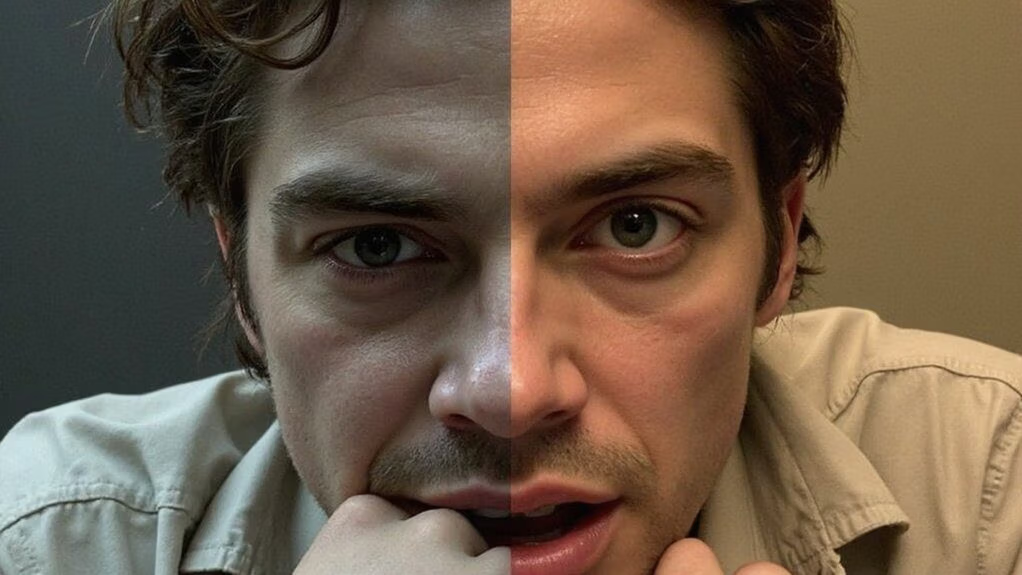You’re likely to notice physical spikes, tense muscles, or short bursts of worry when stress hits, whereas anxiety often feels constant, diffuse, and intrusive. This guide leans on clinical patterns and practical distinctions to help you spot which you’re facing. Keep going — I’ll show clear signs, common overlaps, and when to get extra support.
Physical Signs: Stress Versus Anxiety
Although both stress and anxiety activate your body’s alarm systems, they produce different patterns of physical signs you can track clinically. In stress, you’ll often see transient sympathetic activation: elevated heart rate, brisk blood pressure spikes, short-term increases in cortisol and muscle tension tied to identifiable triggers. Anxiety tends to produce more persistent autonomic dysregulation: palpitations, hyperventilation, diffuse muscle pain, gastrointestinal upset, sweating, and sleep fragmentation that occur with less direct external provocation. Objective monitoring — ambulatory heart-rate variability, actigraphy, and salivary cortisol — helps you distinguish acute stress responses from chronic anxiety patterns. Clinically, document onset, duration, and situational linkage, and integrate biometric data to guide targeted interventions. You’ll validate patients’ experiences while directing innovative, evidence-based treatment plans and measure functional outcomes regularly.
Emotional and Cognitive Clues
Beyond the bodily signs, emotional and cognitive features give you telling diagnostic information that complements biometric data. You’ll notice patterns: stress often produces transient irritability and mental fatigue tied to specific pressures, while anxiety generates pervasive worry, catastrophic thinking, and difficulty disengaging. Clinically, assess intensity, duration, and cognitive content to differentiate them. Use validated scales and brief cognitive probes to quantify symptoms and guide innovation in monitoring.
- Short-lived irritability and task-focused rumination
- Persistent, uncontrollable worry and future-oriented catastrophizing
- Concentration lapses versus relentless mental scanning
- Emotional numbing or overwhelm contrasted with hypervigilance
- Sleep-related cognition: situational preoccupation versus anticipatory dread
You’ll combine subjective report with objective metrics to inform targeted interventions. That integrated profile supports precise, scalable treatment pathways and measurable outcomes for you, starting now.
Behavioral Differences and Daily Impact
How do stress and anxiety change what you do each day? Stress tends to produce short-term behavioral shifts: you’ll prioritize tasks, work longer hours, or withdraw briefly to cope; these changes are situation-linked and usually reversible with rest or problem-solving. Anxiety often causes persistent avoidance, hypervigilance, and rituals that disrupt routines—sleep, concentration, and social engagement degrade over time. Clinically, stress-related behaviors map to acute coping strategies; anxiety-related behaviors align with maladaptive patterns that reinforce fear circuits. You’ll notice productivity fluctuations with stress but sustained functional impairment with anxiety. Interventions differ: targeted problem-solving and workload adjustments help stress, while behavioral activation, exposure, and skill-based therapies address anxiety, and guide measured recovery steps.
When Stress Becomes Anxiety: Overlap and Triggers
When everyday stress persists or escalates, it can cross a threshold into pathological anxiety. You’ll notice symptoms becoming disproportionate, persistent, or impairing despite situational change. Clinical markers include chronic hyperarousal, pervasive worry, and functional decline; neurobiological studies link dysregulated limbic-prefrontal circuits to this progression. Common triggers that push stress into anxiety include:
- Recurrent uncontrollable stressors
- Sleep deprivation and circadian disruption
- Sustained perceived threat or uncertainty
- Preexisting vulnerability (genetic, developmental)
- Cumulative allostatic load from repeated stress
Recognizing overlap helps you clearly differentiate transient strain from disorder and prompts timely assessment. Novel biomarkers and digital phenotyping may refine diagnosis and personalize risk stratification, efficacy testing.
Practical Steps to Cope and Seek Support
Start by taking a brief, structured inventory of your symptoms, stressors, and daily routines so you can target interventions that match what’s actually happening. Then prioritize immediate, low-burden strategies: paced breathing (4-6 breaths/min), 10-minute grounding exercises, brief walks, and sleep hygiene routines — all supported by trials showing symptom reduction. Track responses for two weeks and iterate: increase what helps, stop what doesn’t. Seek scalable support: digital CBT programs, stepped-care models, or brief behavioral activation with a clinician. If symptoms impair functioning or suicidal thoughts arise, contact a mental health provider promptly. Use collaborative care: share your inventory, set measurable goals, and review outcomes regularly. You deserve efficient, evidence-driven options that evolve with your progress. Adjust intensity based on data, and celebrate small, replicable gains.
Conclusion
You’re likely to notice stress as brief physical and emotional spikes tied to specific pressures, while anxiety tends to be persistent, diffuse, and functionally impairing. Use rest, problem‑solving and time-limited strategies for stress; if worry, avoidance, sleep disruption or somatic symptoms persist, seek skill-based treatment or professional help. Early recognition and targeted interventions improve outcomes. You’re not weak for needing support—timely care is clinical, effective and compassionate. Reach out early — evidence shows recovery is faster.

